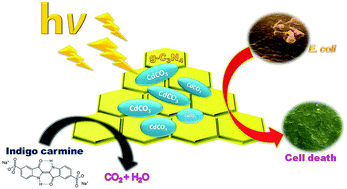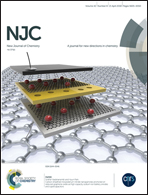Microwave assisted in situ decoration of a g-C3N4 surface with CdCO3 nanoparticles for visible light driven photocatalysis†
Abstract
Graphitic carbon nitride (g-C3N4) supported cadmium carbonate (CdCO3) as an organic–inorganic hybrid nanophotocatalyst was realised by an in situ microwave heating method. The hybrid composite retains the structure of each component, which was verified by p-XRD, FT-IR and solid state 13C-NMR analysis. The as-prepared hybrid g-C3N4/CdCO3 composites were evaluated as a photocatalyst towards the degradation of indigo carmine (IC) dye and inactivation of the Gram negative E. coli pathogen. In this composite, the wide band gap CdCO3 acts as an electron accepting platform from g-C3N4 and facilitates the subsequent photocatalytic reaction. The optimized hybrid g-C3N4/CdCO3-90 photocatalyst exhibits four-fold increase in the degradation of IC dye compared to pristine g-C3N4 and almost a complete mineralization of the dye occurs after 180 min of irradiation. Besides, this photocatalyst completely inhibits the growth of E. coli bacteria within 45 min of visible light irradiation. The enrichment in the photoactivity of CdCO3 decorated g-C3N4 is ascribed to the combined effects of improved visible light absorption, enhanced dye adsorption and facile separation of electron–hole pairs as evidenced by electrochemical impedance spectroscopy (EIS) measurements. The present work may provide valuable information and insights into the microwave assisted synthesis of g-C3N4 hybrid composites and may permit a better comprehension of future advancements in high performance materials for environmental remediation applications.



 Please wait while we load your content...
Please wait while we load your content...